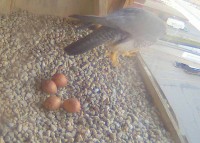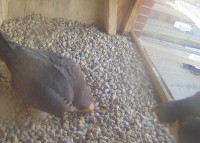Lawrence Peregrines: male from female?
April 23, 2018 in In the Nest Box, lawrence peregrines, Peregrine Falcons Eastern Massachusetts, Peregrine Falcons Massachusetts
Clear skies, bright sun, light wind from the south at 3MPH, and temp just after sunrise at 36°F. Monday morning forecast calls Sunny, with a high near 65. Calm wind becoming south around 5 mph in the afternoon.
At about 5:55 AM, the female rose up from incubation duties, stretched, walked to the edge of the nest box, waied for a moment and flew off. Four minutes later the male entered the box, and then the female pops in and then out again. The male does his half-hearted part to incubate the eggs….moving around, shaking, rocking back and forth, and then side to side. He finally settled in and remained on the egg
One question that has come in from many watchers….how to tell the female and male apart?
- Size: the female is larger than the male; true in most raptors
- Known as sexual dimorphism
- Male typically 1/3 smaller than female
- White stripe between eyes, just above yellow part of the bill, known as cere;
- Head shape: female’s a bit flatter
- Head markings; male has two light spots on back of head
- Female more heavily marked below with broader and fewer bars on average than male
Literature cited: Imprints Blog, The Journal of the Rfalconcam, Rochester Falcon Cam. The Genesee Valley Audubon Society is the local chapter of the National Audubon Society in Rochester, NY. GVAS sponsors the Rochester Falconcam (Rfalconcam) as part of their education and awareness programs.


